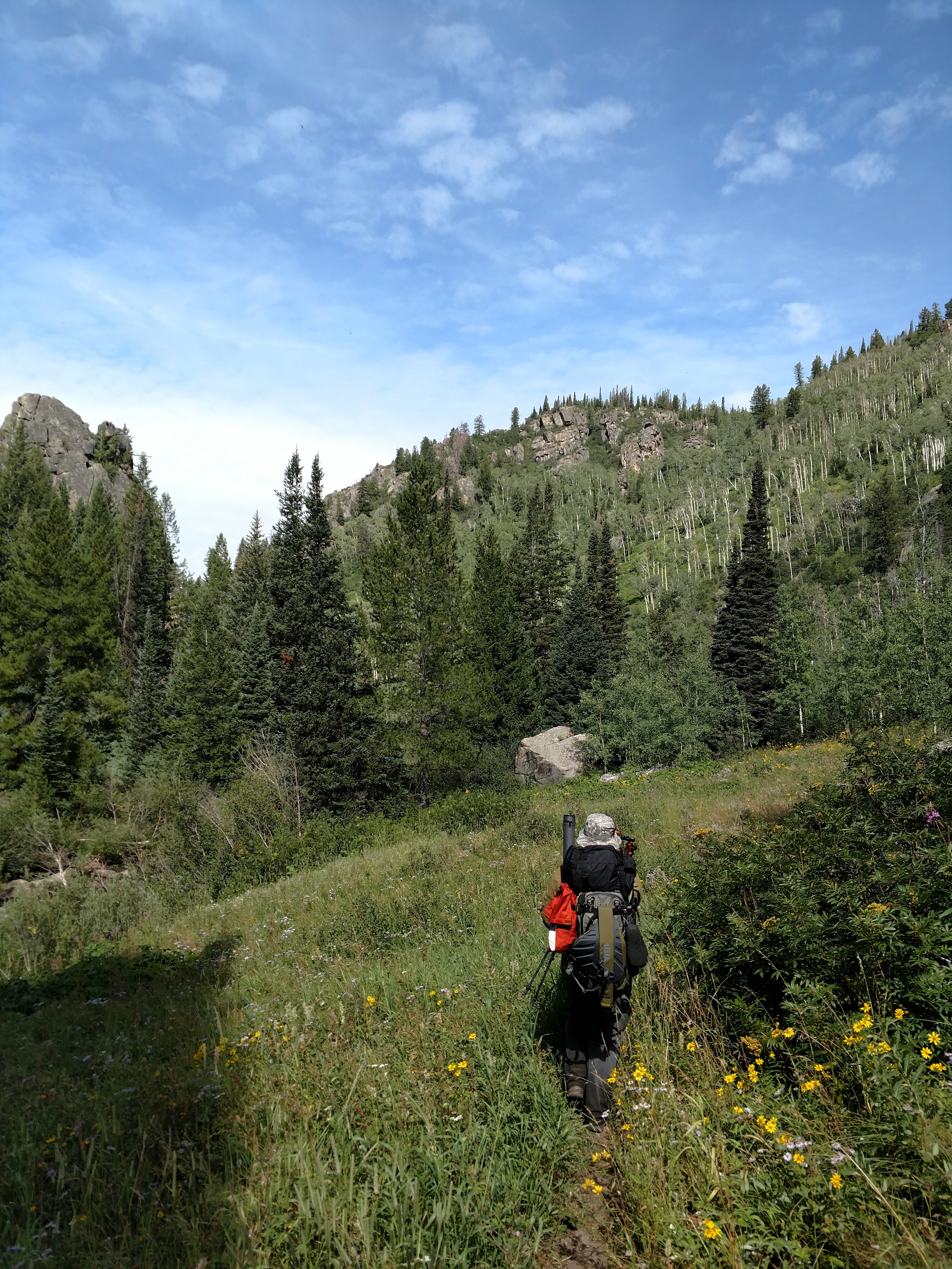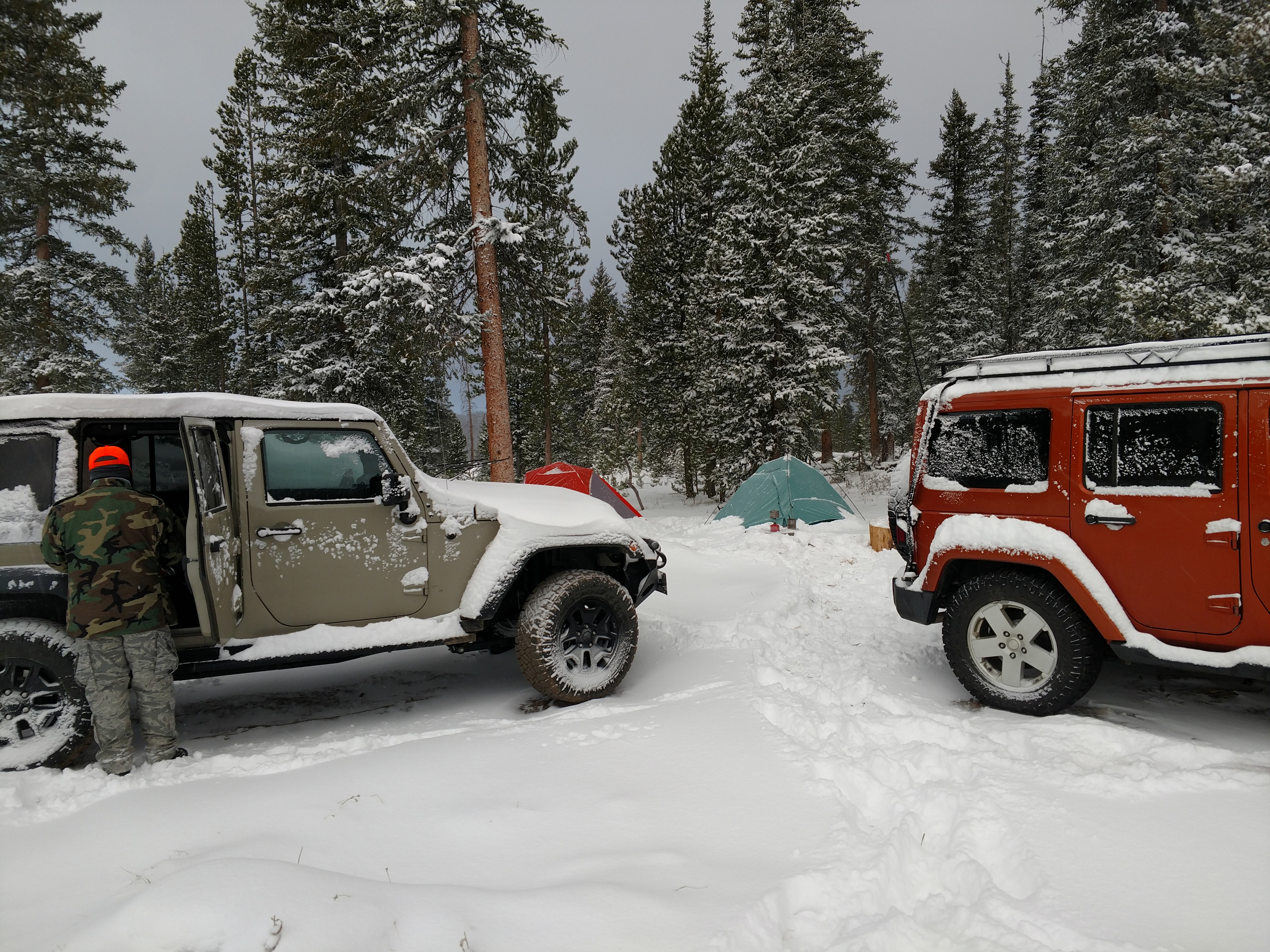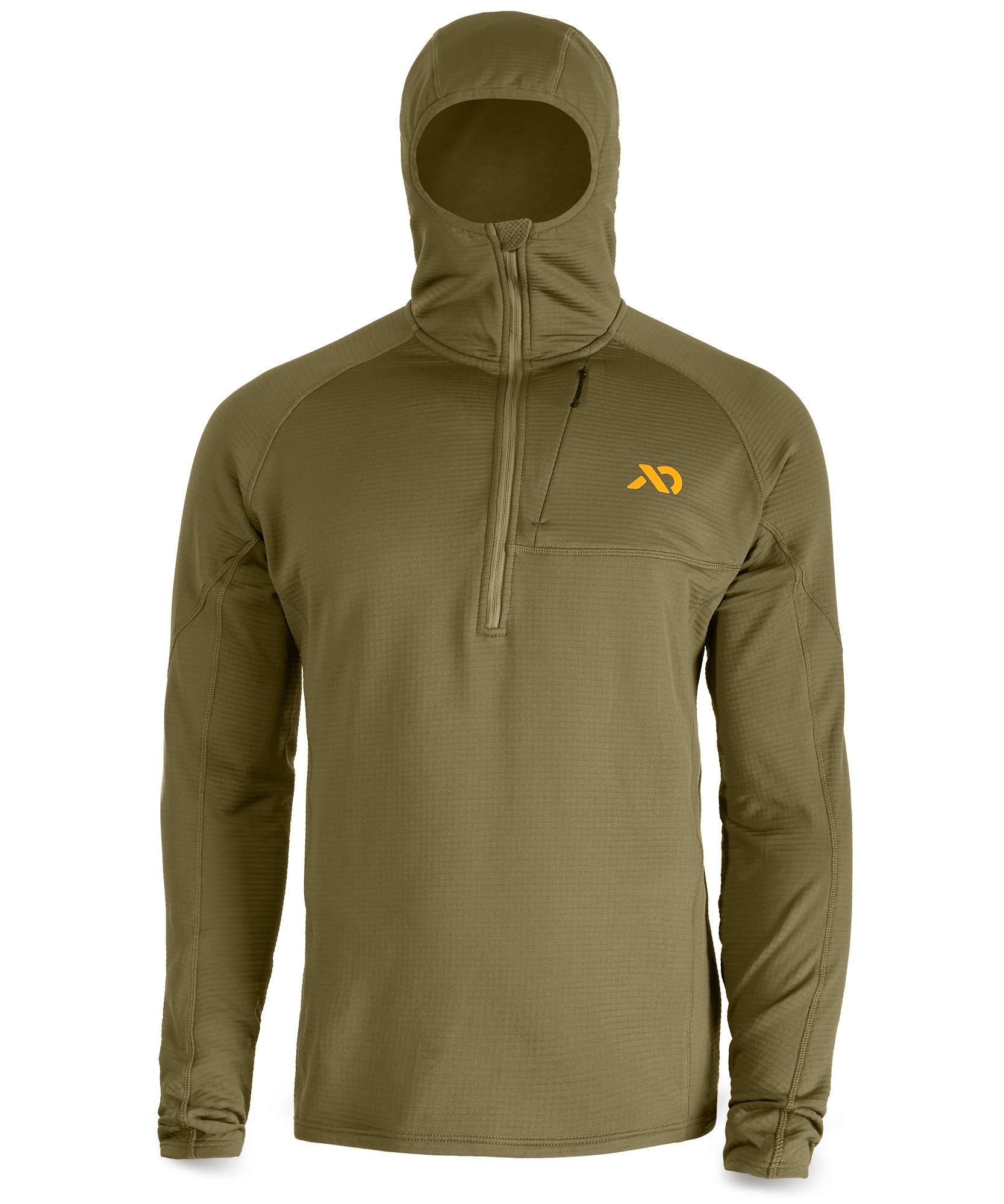Something from Nothing
This past year I’ve decided to begin my foray into being a backcountry hunter for real. What happens though when you’ve, at best, been a car camper all of your life? None of your gear is light, nothing seems quite right. What can you get away with, and what do you need to upgrade? The troublesome response for almost everything seems to be, “it depends”. As you narrow your ground rules you can hone in on your problems that need addressing. Some questions to ask yourself in order to narrow down what needs modified could include:
- How long will you be gone?
- Are you prepared for the weather you’ll experience?
- Is there a water source available near camp?
- Do you intend on making multiple pack-in and pack-out trips?
- How far are you from the trailhead / car?
Obtaining Your Gear
Next, consider your budget and the resources available to you. We’re at the peak of the “end of season sale” timeframe for a lot of winter sports outlets to include Backcountry.com and in a month we’ll have REI’s (operating under MEC in Canada) first of their three 20% off sales for the year. I never really gave those sales the time of day since 20% seems like such a paltry amount. But when you look at certain brands that are rarely discounted, and at the mounting cost of lightweight gear you may have shunned over the years of car camping, well every little bit of savings counts.

In the backpacking world ounces count, but the difference of a couple ounces sometimes means hundreds of dollars, so it’s a balance as to what you can pack in and what you can afford. At the end of the day you need to know what you’re comfortable carrying on your back and train to carry at least that amount.
Your pack
One of the first things to consider is your backpack, you can make do with a day pack for most hunts as I have for years but when you want to go into the backcountry and have camp on your back you’ll find the need to carry at least three or so days worth of stuff with you.

The pack that I’ve chosen for myself will be based off of going out into the backcountry for 5-7 days across three, perhaps four seasons. I bought the Outdoorsman’s Long Range Pack System, complete with a plastic load frame. After agonizing for weeks conducting research I think that pack will suit my needs for hiking and hunting. You can check out our review of the pack here.
You need something with at least as many cubic inches as the gear you’re hauling, and you need to consider what you’re going to do in order to pack meat if and when you get an animal down. The Outdoorsmans pack will separate from the pack frame to either give you a packboard with an optional meat sling, or you can pack game quarters inside the pack if you so desire after you’ve placed them inside of game bags. The latter is not my first choice given the design of the pack. Securing the quarter between frame and bag allows for a more evenly distributed load. Your back will thank you.
Consider also niceties of pack design such as a lower zipper for pulling out camp first — since you’ll pack a majority of your camp items in the bottom of your pack for load balancing sake. You’ll also want some form of hydration with you, and I prefer the use of a hydration bladder. If your pack has an integrated pouch for a bladder, all the better. Otherwise make sure you can fit a Nalgene or two somewhere on the pack.
Learn to Love the Stink
One of the hardest things for me to swallow was the fact that I would need to carry less clothing in the woods. I’ve always packed a giant duffel bag for my multiple week trip to Pennsylvania each year so I could be ready for some eventuality be it rain or snow or being soaked during a creek crossing. Utilizing every mom’s advice of “have a clean pair of underwear!” led to, well, lots of clean pairs of underwear. Here’s the thing though: our septic tank at our cabin is of dubious origin, so we don’t shower every day. Why bother packing all that crap? Further, it weighs a country ton. When you take that packing and scale it down for the trail, you’re going to be a little more conservative lest you throw out your back even before you lose sight of your truck.
Even on my trips to our cabin where I’m able to pack a boatload I’ve adapted in recent years favoring merino wool over polypropylene base layers so as to reduce my stink in the woods and allow for a longer wear rather than changing out layers nearly every day.
In the woods if weather permits you can always take a creek bath — as cold as it may be it’s a refreshing change of pace. I carry a 2 oz bottle of Dr. Bonners peppermint now for just such an occasion.
Items to Focus on
I’m going to go ahead up front and say there are a couple items here I won’t address. That’s going to be boots and some of your clothing items. Those I’ll assume you have already and you’re not going to immediately swap them out. They’re also heavy hitting items that greatly affect overall budget. Your pack will be expensive as it is. So perhaps for the first season we’ll make do with whatever boots you have so long as they’re not 9lbs a piece!
You’ll want to address a couple key items when turning from car camper to backpacker. Namely your backpack, mess kit, water filtration/sterilization, and your sleeping quarters.
Mess Kit
This and your tent/sleeping bag combination is where you’re going to get the most of your weight savings. Most car campers are cooking minimally for two people if not a small family. In order to do that, you’re looking at cookware and dishware that is built for cooking for two people. If you’re going solo, consider something like the GSI Outdoors Soloist. Ditch the spoon though, it’s garbage. You could also consider something like the Snowpeak TI Mini-Solo which is titanium and light as a feather. As much as I pride myself on cooking on American cast iron by Lodge Logic — unless I have a pack animal bringing it in and we’re out there glamping, it stays at home.
Consider your eating implements next, fork, spoon, and knife. If you’re going to be eating the ever-present Mountain House, consider getting a long handled spoon, Sea to Summit makes a nice one. Get used to trimming the package over and over, or just getting messy fingers. A lot of Mountain House entrees are designed as two serving meals and are taller than your typical camp spork. Getting a long handled eating implement will allow you to keep your fingers clean and give you that extra reach in order to get every last morsel.
Cutlery
If you’re hunting, you’ll have a knife with you. For your day-to-day cooking and eating, don’t use the knife you’re going to be breaking down an animal with unless you’re also bringing a sharpener along. Consider a pocket folder for the little camp tasks you need. Just spend a little time thinking about your total load out before packing it up. If you’re a Havalon user, do you really want your Havalon, a Fixed Blade, and another folder? Whatever you’re comfortable with here. To suggest a knife to a hunter would be like suggesting they change their favorite deity; I’m just not up for that today.
Camp Stove
Part of your mess kit this deserves it’s own section for a little more detail. There are a few considerations to keep in mind for a pack stove: weight, fuel, and ease of use. For base camp in car camping you might have the classic Coleman two-burner stove. I’ve got one, my dad had a three burner he could cook an amazing breakfast on at a KOA Kampground. However, you don’t want to lug that through the woods.
I’m going to discount the rocket stoves that run on twigs and sticks for now. I want to stick to fuel I can pick up at pretty much any hardware store. MSR makes a couple really interesting options, but ultimately I went with the MSR WhisperLite Universal.
After it froze up during elk season, I’ve also picked up an MSR Pocket Rocket to minimize cold weather troubleshooting. This is simply a valve with a pot stand that fits on top of a fuel canister. The fuel canister style stoves utilize fuel under pressure, and, unfortunately generate waste for you to pack out — but the mechanisms of the stoves are generally easier to operate and don’t require pumping. It’s all about trade offs.
Camp Grub
If it’s a day hunt I like MRE’s because I can field strip them and lose the weight of stuff I don’t want to either eat or carry. I’ve got a lot of veteran friends who cringe at the thought of willfully eating an MRE ever again. For this I’d suggest heading to your local REI or Sportsman’s Warehouse and checking out their selection of freeze dried vacuum packed meals. Root around and see what you like. Trying a couple meals on a day hike before being trapped with 6 servings of chili mac while in the wilderness. The freeze dried food saves weight and allows you to bring some other protein dense snacks. You’ll be burning a lot of calories whether you’re sitting and shivering or whether you’re putting in the miles attempting to run into some game.
With all that freeze dried food you’ll need water to get it hydrated and palatable again. Which brings me to my next section.
Water Filtration
Don’t skimp here. While there may be clean water where you’re going, at the very least pack some iodine tablets to purify water of any little critters. Otherwise boil the water for two minutes and let it cool. I’m fond of the Steripen solution, a little UV wand you place inside your water to kill off bacteria, but it doesn’t actually filter the water. As I’m doing my research I’m leaning towards a product from Katadyn, the Vario Water Filter which can process about two quarts of water per minute.
Start your hike loaded down with some water and make sure you have a line on a fresh water source if you’re staying more than just the day. At higher elevation you may experience much more dry weather than what you may be used to. Where I am in Colorado, this elevation causes you to require much more water on your hike into the woods.
Tent and Sleeping Bag

These two are where weight can really pile up. It’s hard to get a good, lightweight, four season tent. So unless where you hunt gets unseasonably cold, consider a three season tent. One thing to consider when buying a tent is whether it has a vestibule, somewhere to store your gear out of the weather but out of the tent itself. For me, I tend towards putting my boots out in the vestibule while I sleep so as not to track sand into the floor of my tent.
I prefer a mummy style bag for the purposes of heat retention, but on your first trip or two out you can probably make anything work so long as it’s rated at a lower temperature than you will be experiencing. Remember, temperature is 3.5 degrees lower per thousand feet of elevation gain. So please, note the elevation change from where you’re going to be.
Weapons System
You might not be thinking about this now, but your firearm is a huge source of weight. There’s a reason mountain rifles exist. When you’re hiking at altitude your gun may feel like toting a log if there’s not at least a little weight reduction. You should consider when selecting a pack whether you can carry your weapons system, be it rifle or bow on the pack. How easy does the weapon detach in the event you need it quickly? Consider your pack, what kind of material is it made of? It doesn’t help spending all this money if you sound like someone in a track jacket. “Vrrt vrrrrt vrrrrt!” as the rifle shifts in motion against the pack isn’t natural in the backwwoods.
Miscellaneous Niceties
A few things come to mind before we wrap up items that should be inside your pack. If you’re an addict like me, consider some instant coffee pouches. At least one per day to get you out of camp and on your way. Instant leaves no mess of grinds behind in the woods and weighs practically nothing. The comfort achieved after that first warm cup of black coffee in the morning vastly outweighs what the tiny package bears down on you inside your pack.
Next, consider also your game bags and some ziploc style baggies in gallon size. I normally carry a few ziplocs for offal, collecting the heart and liver into separate bags. Game bags might even be forgotten about for an avid hunter, especially one from the northeastern US like myself where we always drug our deer out whole. Quartering game and skinning it out means that you have bare fleshed quarters and boned out meat in your pack. You’ll want to do everything you can protect it. You’ve earned it. Make sure heavy duty game bags make it onto your packing list.
The last thing I’ll note here is a trowel. Does a bear shit in the woods? Yes. Will you this coming trip? Also yes. Consider getting a lightweight trowel like the TheTentLab’s Deuce of Spades. It’s lightweight and single in purpose. Don’t be the guy or gal who leaves a pile on the forest floor with a flag of TP. Cathole it and bury it or do the LNT thing and pack it out. Some areas require the latter, review local regulations before getting yourself into a shitty situation.
Fall Back Position

As we learned this Elk season sometimes you have to scuttle camp and head back to the cars. It doesn’t make you any less of a badass when personal safety is on the line. There’s no sense in staying in the backcountry when you can’t get back out. In the area where we camped a total of 22″ of snow fell over the course of six days. We were already a half dozen miles into a drive on dirt roads up and down hills over several inches of snow.
I laid out some money this year on gear for backpack hunting, but now the money has been spent and the basic gear has been acquired. I’m on another plateau where no new gear is really necessary, it just improves creature comforts — and that’s a great place to be.





Alex, thank you for the straight-shooter info. I’m taking my second trip in back pack hunting Elk in Colorado, the first was literally a wash, day after day of rain 🙁 I would throw in the towel daily when it went past 13 hours straight, so I still need all of the help I can get. One step at a time. Sometimes you feel like a nut, sometimes you don’t.
Chuckster243
Chuck,
I’ll be doing my second backcountry elk hunt this year as well. I think the major difference this year if I stick to second season will be upgrading to a hot tent. It’s heavier but if you have two or more folks in your crew you can split it up. Being able to run a woodburner in the backcountry would be amazing, especially after the 2019 snow year!
[…] get out and enjoy the winter more and snowshoe, hunt critters I’ve never hunted before, do a little bit of backpack camping, and more. So when I sat down and really thought about what I’d want to do this year in […]